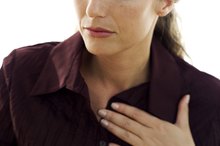What does fact checked mean?
At Healthfully, we strive to deliver objective content that is accurate and up-to-date. Our team periodically reviews articles in order to ensure content quality. The sources cited below consist of evidence from peer-reviewed journals, prominent medical organizations, academic associations, and government data.
- National Heart Lung Blood Institute: Heart Attacks
- National Heart Lung Blood Institute: Heart Attacks
- Mayo Clinic: Heartburn or Chest Pain: When Is It a Heart Attack?
- National Institute of Diabetes and Digestive and Kidney Diseases: Gas in the Digestive Tract
The information contained on this site is for informational purposes only, and should not be used as a substitute for the advice of a professional health care provider. Please check with the appropriate physician regarding health questions and concerns. Although we strive to deliver accurate and up-to-date information, no guarantee to that effect is made.
How to Tell Gas Pains From Heart Pain
Chest pain can be due to infection, disease, anxiety or just be a symptom of a simple abdominal issue like gas, especially if the discomfort is in the upper left chest area. Since more than a million people have heart attacks annually, and almost half of these are fatal, evaluate any chest pain carefully, according to the National Heart Lung and Blood Institute. Gas, while not as serious, is uncomfortable. Most people generate up to two quarts of gas daily and pass it, either by voluntary or involuntary burping, belching or flatulence, more than 10 times a day.
If you are experiencing serious medical symptoms, seek emergency treatment immediately.
Gas Pain Symptoms
Assess your gastrointestinal symptoms as well as note where the discomfort is located, and whether it is a new pain or a recurring one over time. Gas pains can cause sharp, sometimes very intense, abdominal pains. You also may feel bloated and be burping or experiencing flatulence.
What Causes Stomach Swelling & Diarrhea?
Learn More
Write down what you have eaten recently and educate yourself about foods that tend to cause gas. If you are lactose intolerant and have eaten a dairy-filled meal, you may have significant abdominal discomfort within 30 minutes and as long as two hours after eating. Carbonated drinks, pasta, potatoes, corn, beans, cabbage, broccoli and apples all can create gas as your body digests them.
Determine if you are having other physical symptoms as well as noting their duration. Shortness of breath, sweating and arm or jaw pain are not typically associated with gas. A fever with vomiting can indicate more general stomach upset or a virus.
- Assess your gastrointestinal symptoms as well as note where the discomfort is located, and whether it is a new pain or a recurring one over time.
- If you are lactose intolerant and have eaten a dairy-filled meal, you may have significant abdominal discomfort within 30 minutes and as long as two hours after eating.
Heart Attack Symptoms
Gas, Abdominal Pain & Bloating After Eating
Learn More
Review your family history for cardiac problems. If you or your immediate relatives do have known heart disease, be sure others in your life know. Many deaths from heart failure happen within the first 60 minutes of symptoms.
Evaluate your lifestyle for heart problems. Your chances of a heart attack increase if you are overweight, inactive, diabetic, deal with have high cholesterol or high blood pressure or if you smoke. General risk of a heart attack also increases with age--after 45 for men and after 55 for women.
Know the physical symptoms of a heart attack. Squeezing, tightening or pressure in the middle of the chest that continues for several minutes and may radiate into the arms, particularly the left arm, shoulder or jaw may indicate a heart attack 1. Also call for emergency help if you are suddenly dizzy, short of breath, break into a cold sweat or feel nauseated.
Tips
While gas problems are not life threatening, if frequent discomfort caused by gas prevents you from carrying out regular activities, you should see your doctor.
Heart attacks are seldom as dramatic as the movies portray. An attack often starts slowly as mild chest pain or discomfort. If you are unsure, call for help, because fast intervention can save your life.
Warnings
Heart disease is the top cause of death in the United States.
In addition to chest pressure, women more often experience the other symptoms associated with a heart attack, including shortness of breath, nausea and back or jaw pain.
- Review your family history for cardiac problems.
- Your chances of a heart attack increase if you are overweight, inactive, diabetic, deal with have high cholesterol or high blood pressure or if you smoke.
Related Articles
References
- Mayo Clinic: Heartburn or Chest Pain: When Is It a Heart Attack?
- Lichtman JH, Leifheit EC, Safdar B, et al. Sex Differences in the Presentation and Perception of Symptoms Among Young Patients With Myocardial Infarction: Evidence from the VIRGO Study (Variation in Recovery: Role of Gender on Outcomes of Young AMI Patients). Circulation. 2018;137(8):781-790. doi:10.1161/CIRCULATIONAHA.117.031650.x
- Jackson MN, Mcculloch BJ. 'Heart attack' symptoms and decision-making: the case of older rural women. Rural Remote Health. 2014;14:2560.
- Benjamin EJ, Virani SS, Callaway CW, et.al. Heart Disease and Stroke Statistics—2018 Update: A Report From the American Heart Association. Circulation. 2018;137:e67–e492. doi:0.1161/CIR.0000000000000558
- Body R, Carley S, Wibberley C, et al. The Value of Symptoms and Signs in the Emergent Diagnosis of Acute Coronary Syndromes. Resuscitation. 2010 Mar;81(3):281-6. doi:10.1016/j.resuscitation.2009.11.014
- Cedars-Sinai. Heart Attack (Myocardial Infarction).
- Cleveland Clinic. Women: Don’t Ignore These 3 Subtle Heart Attack Symptoms. Mar 3, 2016.
- Fanaroff AC, Rymer JA, Goldstein SA, et al. Does This Patient With Chest Pain Have Acute Coronary Syndrome?: The Rational Clinical Examination Systematic Review. JAMA. 2015 Nov 10;314(18):1955-65. doi:10.1001/jama.2015.12735
- Mehta LS, Becki TM, DeVon HA. Acute Myocardial Infarction in Women: A Scientific Statement from the American Heart Association. Circulation.Circulation. 2016;133:916–947. doi:10.1161/CIR.0000000000000351
- National Heart, Lung, and Blood Institute. Heart Attack.
- Thygesen K, Alpert JS, Jaffe AS, et al. Third Universal Definition of Myocardial Infarction. Circulation. Oct 16, 2012;126:2020–2035. doi:10.1161/CIR.0b013e31826e1058
Tips
- While gas problems are not life threatening, if frequent discomfort caused by gas prevents you from carrying out regular activities, you should see your doctor.
- Heart attacks are seldom as dramatic as the movies portray. An attack often starts slowly as mild chest pain or discomfort. If you are unsure, call for help, because fast intervention can save your life.
Warnings
- Heart disease is the top cause of death in the United States.
- In addition to chest pressure, women more often experience the other symptoms associated with a heart attack, including shortness of breath, nausea and back or jaw pain.
Writer Bio
Emily Claassen has been a writer, editor and publication designer since 1986. During college, she was a reporter for a daily newspaper. Since then, she has worked primarily for educational institutions, research organizations and nonprofit clients, writing and editing a variety of material. She has a Bachelor of Journalism from the University of Missouri-Columbia.









